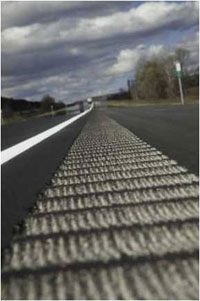Safety issue
Roadway departure crashes account for approximately 50 percent of fatal crashes each year on the nation's highways. Roadway departure crashes are typically severe in nature.
Safety design
Rumble strips are an engineering treatment designed to alert drivers of a lane departure through vibration and noise created when a vehicle's tires contact the rumble strip. Shoulder and centerline rumble strips on rural two-lane roads are especially helpful during bad weather such as rain, snow or fog when visibility of the edge line or centerline is reduced. Rumble strips also help to reduce inattentive driving crashes due to fatigue, drowsiness and inattention.
Shoulder rumble strips help to reduce fatal and injury lane departure crashes by up to 29 percent by alerting drivers to lane departures. Lane departure crashes account for over one-third of all fatal and injury crashes each year, with 90 percent taking place on rural Wisconsin highways. Rumble strips will not eliminate all run-off-road crashes especially those caused by excessive speed, sudden turns to avoid on-road collisions, or high-angle encroachments.
Benefits
- Low cost and relatively quick to install
- Direct feedback/guidance to the driver
- Rural Two-Lane Highways - Centerline rumble strips have shown to reduce fatal and injury crashes by 31%
- Rural Two-Lane Highways - Shoulder rumble strips have shown to reduce fatal and injury crashes by 8%.
- Rural Multilane Highways - Shoulder rumble strips have shown to reduce fatal and injury crashes by 37%
- Urban Freeways - Shoulder rumble strips have shown to reduce fatal and injury crashes by 16%
View Federal Highway Administration video on the benefits of rumble strips
Where are they being used?
-
Shoulder rumble strips are installed on all freeways and on two-lane highways where the paved shoulder is 5 feet or greater.
-
Center line rumble strips are installed at or near the center line of an undivided roadway.